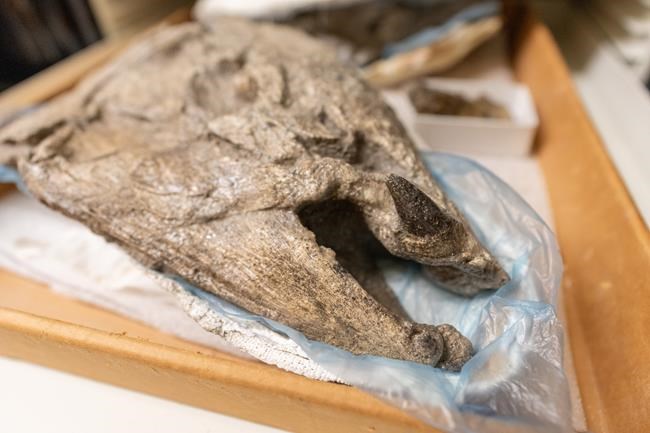Giant prehistoric salmon had tusk-like spikes used for defence, building nests: study
By The Canadian Press on April 24, 2024.
 A spike-tooth salmon fossil is shown on display at the University of Oregon in this handout image. About five million years ago, the largest salmon known to have lived migrated through the coastal waters of the Pacific Northwest, and a new paper uses revelations from fossil discoveries to reimagine and rename the great fish. THE CANADIAN PRESS/HO-University of Oregon *MANDATORY CREDIT
A spike-tooth salmon fossil is shown on display at the University of Oregon in this handout image. About five million years ago, the largest salmon known to have lived migrated through the coastal waters of the Pacific Northwest, and a new paper uses revelations from fossil discoveries to reimagine and rename the great fish. THE CANADIAN PRESS/HO-University of Oregon *MANDATORY CREDITA new paper says a giant salmon that lived five million years ago in the coastal waters of the Pacific Northwest used tusk-like spikes as defense mechanisms and for building nests to spawn.
The initial fossil discoveries of the 2.7-metre-long salmon in Oregon in the 1970s were incomplete and led researchers to suggest the fish had fang-like teeth.
The now-extinct fish was dubbed the “saber-tooth salmon,” but the study published in the peer-reviewed journal PLOS One today renames it the “spike-toothed salmon” and says both males and females possessed the “multifunctional” feature.
Study co-author Edward Davis says the revelation about the tusk-like teeth came after the discovery of fossilized skulls at a site in Oregon in 2014.
Davis, an associate professor in the department of earth sciences at the University of Oregon, says he was surprised to see the skulls had “sideways teeth.”
Contrary to the belief since the 1970s, he says the teeth couldn’t have been used for any kind of biting.
“That was definitely a surprising moment,” Davis says of the fossil discovery in 2014. “I realized that all of the artwork and all of the publicity materials … we had just made two months prior, for the new exhibit, were all out of date.”
This report by The Canadian Press was first published April 24, 2024.
9-8


